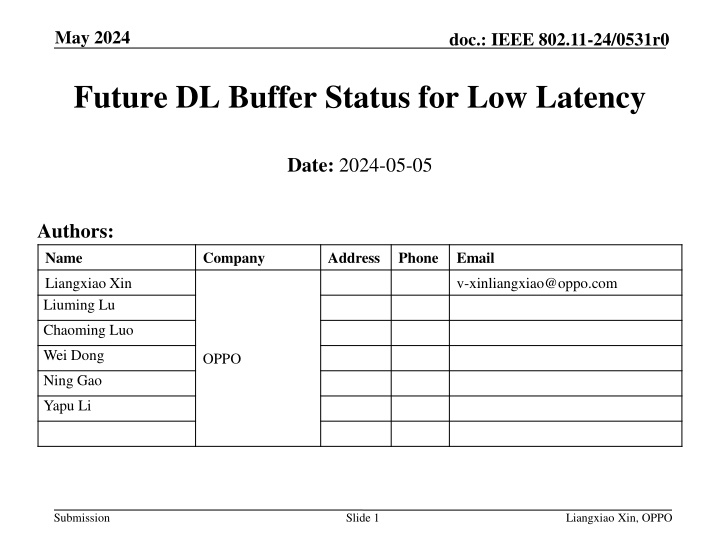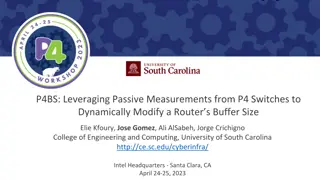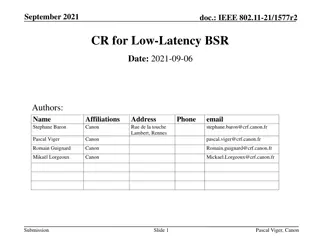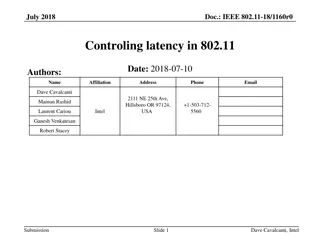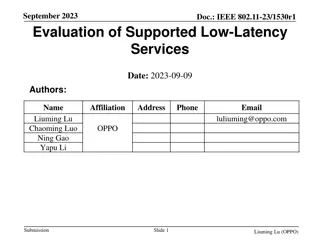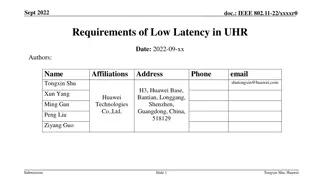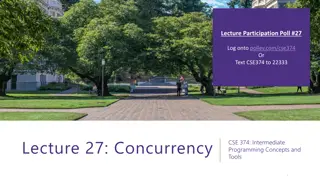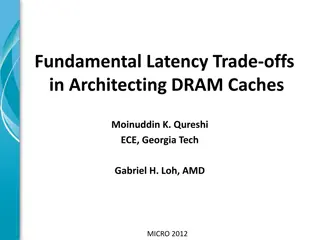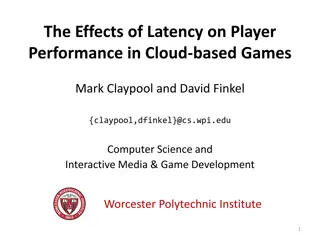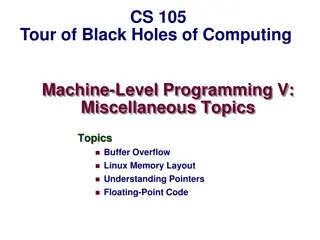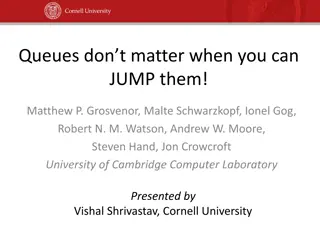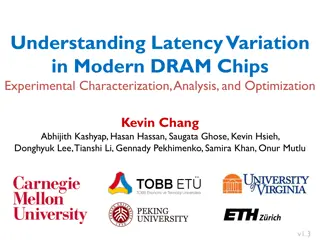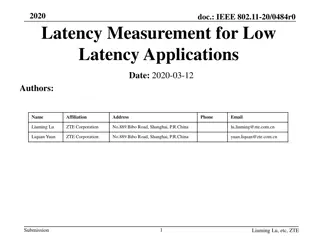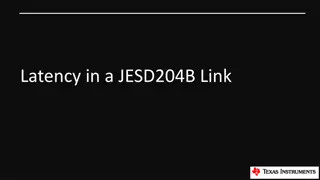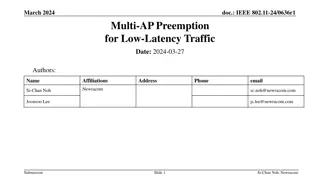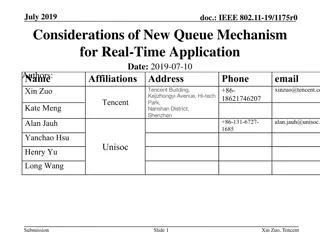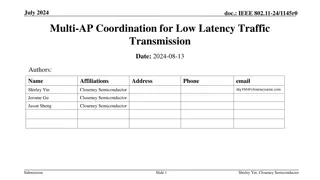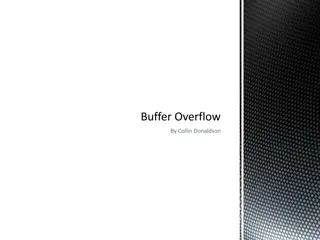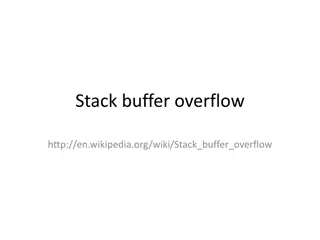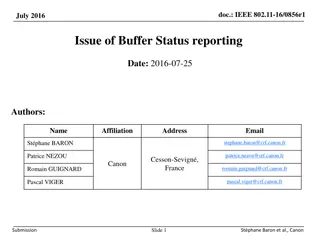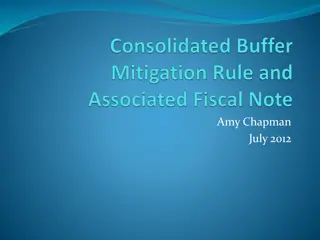Future DL Buffer Status for Low Latency
This document outlines the improvement of latency performance in Wi-Fi networks with a focus on round-trip delay, discussing traffic flow types and comparisons. It also details a service event in the Wi-Fi network and key performance indicators associated with it.
Download Presentation

Please find below an Image/Link to download the presentation.
The content on the website is provided AS IS for your information and personal use only. It may not be sold, licensed, or shared on other websites without obtaining consent from the author.If you encounter any issues during the download, it is possible that the publisher has removed the file from their server.
You are allowed to download the files provided on this website for personal or commercial use, subject to the condition that they are used lawfully. All files are the property of their respective owners.
The content on the website is provided AS IS for your information and personal use only. It may not be sold, licensed, or shared on other websites without obtaining consent from the author.
E N D
Presentation Transcript
May 2024 doc.: IEEE 802.11-24/0531r0 Future DL Buffer Status for Low Latency Date: 2024-05-05 Authors: Name Company Address Phone Email Liangxiao Xin Liuming Lu v-xinliangxiao@oppo.com Chaoming Luo Wei Dong OPPO Ning Gao Yapu Li Submission Slide 1 Liangxiao Xin, OPPO
May 2024 doc.: IEEE 802.11-24/0531r0 Introduction TGbn targets to improve the latency performance of Wi-Fi network in its next generation. For now, a lot of discussions and contributions are made to improve the end-to-end delay. However, there are few contributions to discuss the round-trip delay, which is an important KPI in many real-time applications. In this contribution, we discuss the use case of round-trip delay and its standard impact. Submission Slide 2 Liangxiao Xin, OPPO
May 2024 doc.: IEEE 802.11-24/0531r0 Traffic Flow Types in RTA There are two basic types of traffic flow in RTA Publish: A server publishes information (e.g., sensor data) to its clients (periodically). Service: A client occasionally sends service request message (e.g., request sensor data) to its server and server provides the corresponding service (e.g., provide sensor data) to the client. Service Request Publish Information Service Response Server Client Client Server Type 1: Publish Type 2: Service Submission Slide 3 Liangxiao Xin, OPPO
May 2024 doc.: IEEE 802.11-24/0531r0 Comparison of two flow types Type 1: Publish One direction Periodic/semi-periodic End-to-end delay Type 2: Service Bi-direction Aperiodic Round-trip delay Traffic direction Frequency of occurrence KPI Data Frame (Service Request) Data Frame (Publish Information) Data Frame (Service Response) Server Type 1 Client Type 2 Client Server IEEE 802.11 has discussed Type 1 since TGbe but not discussed Type 2. Submission Slide 4 Liangxiao Xin, OPPO
May 2024 doc.: IEEE 802.11-24/0531r0 An Service Event in Wi-Fi network 1. Non-AP STA sends data frame carrying Service Request message to AP. Service Request message is created at the APP layer of non-AP STA (Client). AP forwards the Service Request message to Server and receives the Service Response message from Server The message exchange could happen in or outside Wi-Fi network. AP sends data frame carrying Service Response message to non- AP STA. 1. Data Frame (Service Request) 2. 3. 2. Request and Response Messages Exchange 3. Data Frame (Service Response) (Server) Non-AP STA (Client) AP Submission Slide 5 Liangxiao Xin, OPPO
May 2024 doc.: IEEE 802.11-24/0531r0 KPI of Service Event The KPI of a service event is Round-trip delay which is the duration of a service event. The start time of a service event is the time when Service Request arrives at the non-AP STA, which is aperiodic. A service event 3. Data Frame (Service Response) 2. Request and Response Messages Exchange 1. Data Frame (Service Request) Non-AP STA ACK/ BA UL DATA (Service Request) ACK/ BA DL DATA (Service Response) AP Round-trip delay Service Request arrives at non-AP STA Service Response arrives at AP Submission Slide 6 Liangxiao Xin, OPPO
May 2024 doc.: IEEE 802.11-24/0531r0 Logic of design The target is to improve the round-trip delay of a service event. The current logic of IEEE 802.11 of improving the end-to-end delay is to let AP know the expected arrival time of LL traffic and schedule SPs to transmit LL traffic. R-TWT: schedule periodic R-TWT SPs to prioritize the LL traffic SCS: indicate the QoS characteristics of the LL traffic and schedule SPs However, it is difficult to predict the start time of a service event. AP cannot use R-TWT, SCS to schedule a SP for a service event in advance. Can we design a mechanism following the current logic to improve the round-trip delay? We need to analyze which parameters are predictable in a service event and use those predictable parameters to improve the round-trip delay. Submission Slide 7 Liangxiao Xin, OPPO
May 2024 doc.: IEEE 802.11-24/0531r0 Which parameters are predictable? It is difficult to predict the start time of a service event. However, after a service event starts, non-AP STA can predict P1: The time that service response will arrive at AP, P2: The deadline when non-AP STA should receive the service response, P3: The size of the service response. A service event 3. Data Frame (Service Response) 2. Request and Response Messages Exchange 1. Data Frame (Service Request) Non-AP STA P1 ACK/ BA UL DATA (Service Request) ACK/ BA DL DATA (P3) (Service Response) AP P2 Round-trip delay Service Request arrives at non-AP STA Service Response arrives at AP Submission Slide 8 Liangxiao Xin, OPPO
May 2024 doc.: IEEE 802.11-24/0531r0 Proposed Solution The idea is to provide AP the predictable parameters of a service event so that AP can use them to schedule SP in advance to transmit the service response. We propose to define Future DL Buffer Status Future DL buffer Size: the expected buffer size of service response Expected Arrival Time: the expected time that the service response will arrive at AP. Expiration Time: the deadline for AP to finish the transmission of the service response to meet the round-trip delay requirement When STA transmits service request in a data frame, the data frame carries the future DL buffer status. AC/TID Scaling Factor Size Queue Expected Arrival Time Expiration Time Submission Slide 9 Liangxiao Xin, OPPO
May 2024 doc.: IEEE 802.11-24/0531r0 Example AP schedules a service period (time between Expected Arrival Time and Expiration Time) to transmit the service response . AP arranges resources to transmit service response during the SP, e.g., Enable high capability mode before expected arrival time Enable preemption during the time window MU-RTS/CTS Expected Arrival Time Expiration Time Service Period UL DATA (Service Request +Future DL buffer) ACK/ BA Non-AP STA ACK/ BA DL DATA (Service Response) AP Submission Slide 10 Liangxiao Xin, OPPO
May 2024 doc.: IEEE 802.11-24/0531r0 Summary In this contribution, we show a use case where round-trip delay is important KPI and discuss the standard impact of such use case. 11bn shall define a mechanism to improve the round-trip delay performance of such use case. We propose to define a future DL buffer status which includes Expected Arrival Time and Expiration Time AP can use the information in the future DL buffer status to schedule the SP in advance to meet the round-trip delay requirement of the use case. Submission Slide 11 Liangxiao Xin, OPPO
May 2024 doc.: IEEE 802.11-24/0531r0 SP1 Do you support to include the following in SFD? 11bn shall define a mechanism to address the round-trip delay use case. Submission Slide 12 Liangxiao Xin, OPPO
May 2024 doc.: IEEE 802.11-24/0531r0 SP2 Do you support to include the following in SFD? 11bn shall define a new type of BSR which includes the delay requirement information for LL traffic. Submission Slide 13 Liangxiao Xin, OPPO
May 2024 doc.: IEEE 802.11-24/0531r0 SP3 Do you support to include the following in SFD? 11bn shall define a new type of BSR including the following parameters to improve the round-trip delay Expected Arrival Time Expiration Time Future DL Buffer Size Submission Slide 14 Liangxiao Xin, OPPO
